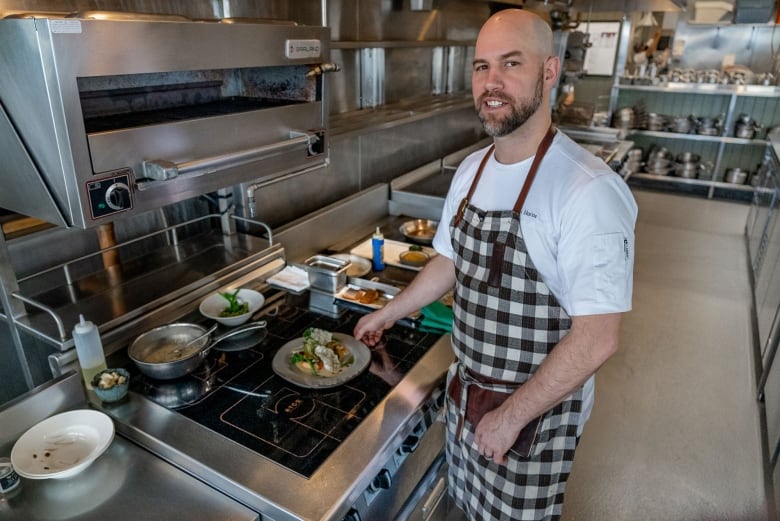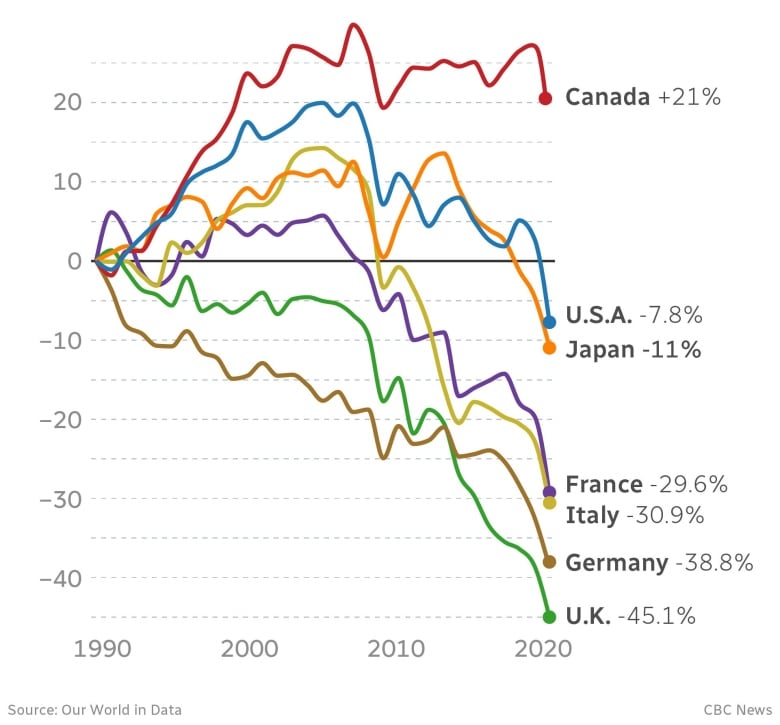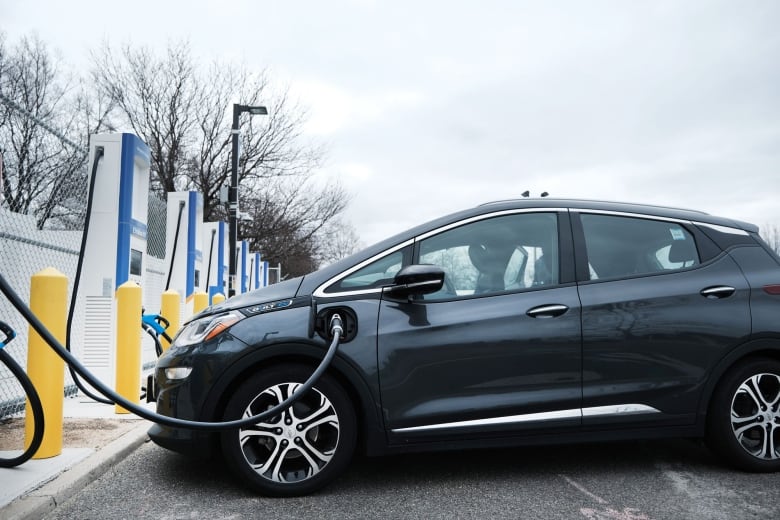Hello, Earthlings! This is our weekly newsletter on all things environmental, where we highlight trends and solutions that are moving us to a more sustainable world. (Sign up here to get it in your inbox every Thursday.)
This week:
- Professional chefs tout the culinary — and environmental — advantages of induction stoves
- Comparing Canada’s emissions to the rest of the G7
- Readers share their experiences with electric vehicles
Professional chefs tout the culinary — and environmental — advantages of induction stoves

Most serious home cooks consider a high-end gas stove to be essential.
But professional chefs who create gourmet dishes on electric induction stoves are heating up the debate.
While the environmental and health risks of gas stoves have been making news, these chefs make the case that induction cooking is not only cleaner but also leads to better culinary results.
Unlike gas or traditional electric stoves, induction doesn’t use thermal energy, meaning the unit doesn’t heat up the air or even the cooking surface. These stoves use electricity to heat pots and pans through electromagnetic induction, which means you can put your hand on the stovetop and feel no heat whatsoever.
Because all the energy goes directly into the pot and the food inside it, induction provides faster, more efficient cooking, as well as energy savings and easy cleanup, since spills on the cooktop never burn.
John Horne, an executive chef at Oliver & Bonacini Restaurants in Toronto, has been doing a lot of online cooking demos from his home kitchen during the pandemic. He says his viewers were surprised to see that he cooks on induction at home.
His house came with a gas stove when he bought it, but he swapped it out within weeks. “I couldn’t adjust to how much slower a home gas stove was compared to an induction, so I switched that out to an induction and I haven’t looked back since.”
Horne says water takes about half as long to boil on induction as on a gas stove. He also loves cooking with his two young children, so a stove with a surface that never gets hot is a huge benefit.
Horne’s been cooking on induction for about 15 years, first as a professional chef in Europe and now overseeing several high-end restaurants, including Canoe in Toronto. So when he points out his reasons for cooking with induction, serious foodies tend to listen.
“Canoe is one of the busiest restaurants in Canada by far, and we need the firepower of induction to keep up with the business,” he said. (Canoe is on the 54th floor of the TD Bank Tower, so along with the CN Tower’s sky-high restaurant, Canoe is not allowed to use gas stoves for safety reasons.)
Vancouver restaurateur Angus An chose an all-induction kitchen for his Fat Mao Noodles restaurant. With a small open kitchen, right off the front door, he said induction was the right choice. “You don’t feel that heat when you walk into a busy kitchen. It’s not heating up the space. It’s almost like magic.”
Jonathan Kung, a chef and social media celebrity based in Detroit, discovered portable induction burners more than a decade ago while doing pop-ups in nightclubs and bars, places that often had no ventilation and little space. He became a fan for life.
Kung’s pandemic livestreams, about making cooking fun and accessible with a focus on Chinese North American cuisine, have earned him 1.5 million followers on TikTok. One of the things he loves is how precisely he can set his temperatures.
“You don’t have to worry about it getting too hot and burning the oil or getting too cold, it just does it for you.”
Induction can be expensive to install if you have a functioning gas stove you’d need to swap out, and there is a bit of an adjustment to how fast the food cooks. Angus An said he doesn’t think induction will ever fully replace gas because people do enjoy the experience of an open flame, but he thinks it could replace electric stoves.
While upping their cooking game is the No. 1 reason these chefs love induction, the health benefits of not cooking with gas and the ability to reduce greenhouse gas emissions come as a welcome bonus.
That’s why Kung partnered with Mothers Out Front, a climate advocacy group, to produce a video to explain the health and environmental benefits of cooking with induction. He said he was happy to share information that squares with the values of his younger fans, who he said care more about sustainability.
“Younger people care about their health as an important part of their lifestyle,” he said. “They also care about the environment because they are young and they … have to spend more time on this earth.”
– Alice Hopton
Reader feedback
Most of the feedback this week was to our electric vehicle story. We’ve collected it below. Just scroll down….
Old issues of What on Earth? are right here.
There’s also a radio show and podcast! Just days after a UN report warned of dire consequences if countries do not drastically reduce their emissions, Ottawa approved Bay du Nord, an offshore oil mega-project. This week on What On Earth, a look at the doubt that decision casts on Canada’s climate commitments. What On Earth airs Sunday at 12:30 p.m., 1 p.m. in Newfoundland. Subscribe on your favourite podcast app or hear it on demand at CBC Listen.
The Big Picture: Canada’s CO2 emissions vs. the G7
This week, the UN’s Intergovernmental Panel on Climate Change released another chilling assessment of worldwide efforts to avert the worst impacts of global warming. The gist of it? We need to do a lot better. The report said that keeping warming to 1.5 C above pre-industrial levels is nigh impossible without massive cuts to carbon emissions. Even to meet the less-desirable target of 2 C warming, we would need to ensure emissions plateau by 2025 and decline thereafter.
In an effort to tame Canada’s carbon pollution, the federal government has rolled out a number of promising-sounding initiatives, most recently the Emissions Reduction Plan. As the graph below shows, Canada has performed poorly in comparison to its peers in the G7 when it comes to emissions between 1990 and 2020. It’s the only country to see emissions grow in that time, thanks largely to increased production of oil and gas (especially in the Alberta oilsands). The U.K., meanwhile, has reduced emissions by 45 per cent since 1990, due partly to a drawdown of coal power.
In his comment on the latest IPCC report, UN Secretary General Antonio Guterres said, “Climate activists are sometimes depicted as dangerous radicals. But the truly dangerous radicals are the countries that are increasing the production of fossil fuels. Investing in new fossil fuels infrastructure is moral and economic madness.”
On Wednesday, the Canadian government approved the Bay du Nord oil project off the coast of Newfoundland.

Hot and bothered: Provocative ideas from around the web
Your responses to our electric vehicle story

Last week, Andre Mayer wrote about some of the challenges of driving electric vehicles for long distances. We hoped it would spur a response from readers — and you didn’t let us down.
Jane Bonsteel wrote:
“I have a plug-in hybrid that I drove to Nova Scotia from Ontario last summer. It is not compatible with Level 3 chargers. Charging stations were few and far between. I also found that using various charging stations was complicated. For example, I camped at a provincial park in New Brunswick that had a Level 2 charging station owned by NB Power. But first I needed to download an app and I had very little data left on my phone, so off I went in search of Wi-Fi. Then the app would not download properly. When I eventually downloaded the app later in the day, I found I was required to sign up for an account, provide my credit card information and put money on that account, all before I could charge my car for two hours. I did not want to put money on an app account that I may never use again. All gas stations take credit cards for direct payment; a separate app and account are not required. The same must go for EV charging stations.”
Dennis Nella:
“I recently purchased a Hyundai Ioniq 5, which I’m happy with. The 488-km range is good, and I mostly charge at home. But when I’ve done road trips, my experience has been frustrating. With a gas car, I would have my credit card approved, pump the gas and leave. I didn’t need to download a different app for each company’s stations. Most of the times I’ve tried to charge at public chargers, I’ve had problems, despite having the app. There is a learning curve for someone like myself who isn’t so tech-savvy.”
Hélène Grandmaître:
“We have had a Nissan Leaf since 2019. Our experiences in driving longer distances were challenging. Charging stations are often broken, do not seem to work with our credit card. Petro-Canada seems uninterested in maintaining their charging stations…. Until Ontario is serious about charging stations, my Leaf is my around-town vehicle.”
Gavin Hutchison offered some suggestions for minimizing the challenges for both yourself and others.
“I have driven an EV for nine years. I am on my second Leaf, a 2018 with a 40KWh battery. I only get 200 kilometres on the highway per charge. I use the PlugShare app to find charging stations. It has all the different network chargers. It also gives you a method to input how your charging experience went. I strongly recommend using this app and checking if anyone was unable to charge recently. This can be a big help. I also leave comments both positive and negative to help my fellow EV drivers.
“When I have had problems at charging stations I always call the 1-800 number for assistance. With Petro-Canada’s number it is a common number and you have to listen to all the prompts to find the EV assistance prompt … When you use that prompt, you get a technician who can usually reboot the charger remotely, which often fixes the problem.”
James Strickland wrote in, saying, “I am left wondering whether the author is genuinely unaware of the existence of Tesla … or whether there is some deliberate intention to perpetuate myths.”
Tesla is, of course, known to us, and we recognize its foresight in building a charging infrastructure to support its vehicles. The reason we didn’t include a mention in the original article is because a) the author has never driven a Tesla, and thus couldn’t speak to the driving/charging experience, and; b) Tesla chargers have long been off-limits to other EV drivers.
But a number of Tesla drivers wrote in.
Ed Chessor:
“We have driven our Tesla 3 from Vancouver to Palm Springs [California] and back three times. The Supercharging system makes it easy to do the drive in three days, just like we did with our Honda CRV and the Ford Focus before that. Six weeks after we got the Tesla, we did a trip to Tofino, Ucluelet and Campbell River. We used Level 2 chargers everywhere, with the Flo card. It worked fine, and all the charging was free.”
John Dove made a couple of key points:
“I suggest that one app is not enough to cover all of the chargers available. As a Tesla owner I can of course use the proprietary Tesla app — but I also make use of other apps such as Flo and ChargeHub (both have strong focus on Canadian locations) and PlugShare. The Petro-Canada Electric Highway app and the Ivy app (consortium of HydroOne and Canadian Tire in Ontario) also locate chargers for those vehicles with DCCS and ChaDeMo ports (Level 3)…
“Readers should know that an EV can be charged anywhere. A 120V standard receptacle (such as a block heater receptacle) will provide 4-6 km/hr; a Level 2 (240V) charger such as that found at hotels, shopping malls, etc., will provide 18 km/hr; and Level 3 (600V+) high-speed chargers will usually provide the full vehicle range within the hour.”
David Ohrling:
“We have taken many road trips in our EV, including north to Pukaskwa National Park and east to Quebec City, and it is not only realistic, it is better. The extra time spent recharging is minimal when combined with stretching your legs, eating and washroom breaks, especially when you factor in leaving home with a full charge and in many cases charging at your destination. An EV is easier to drive with cruise and [regenerative breaking] mode and you arrive at your destination less frazzled. It is far less expensive. It is better for the planet. We need to move beyond focusing on the exaggerated inconveniences and recognize the obvious advantages. Not only is it realistic, it’s the way we need to go.”
Finally, Eric McInnis provided this perspective:
“We expect gas stations to … overhaul their own infrastructure to accommodate the new age of transport. Truth is, going to a gas station has always been inconvenient, despite being a mere five-minute sidetrack.… They are stinky, and the store’s merchandise is grossly overpriced — not to mention gas prices today. The best part is, electricity doesn’t need huge tanks for storage; in fact, electricity already exists literally everywhere.
“The solution, the onus, is on all of us to think outside the box. Where is more of our time spent? Work for anywhere from four to 12 hours, grocery and retail shopping for one, maybe two hours, cinemas for two or three hours, the gym, local and national parks, sit-in restaurants, hockey arenas — the list is endless. Those are all things we are already doing, things we actually like to do. Go to work, plug in; go get groceries after work, plug in; go see a movie, plug in; go work out, plug in. The best part, it can be done on a Level 2 network. There will be less [battery] pack degradation, and an endless source of charging power where we would almost never end up below 80 per cent at any time, other than long-distance travel.
“So yes, Petro Canada’s chargers are sorely needed, but they don’t need to shoulder the burden of the entire industry any longer. Being able to start every day with 350+ km of power is a massive leg up on gassers, and being able to charge where we already go is the most logical next step.”
Stay in touch!
Are there issues you’d like us to cover? Questions you want answered? Do you just want to share a kind word? We’d love to hear from you. Email us at whatonearth@cbc.ca.
Sign up here to get What on Earth? in your inbox every Thursday.
Editor: Andre Mayer | Logo design: Sködt McNalty













Leave a comment